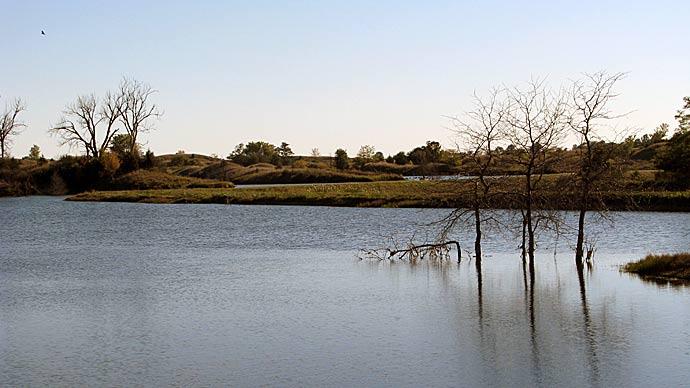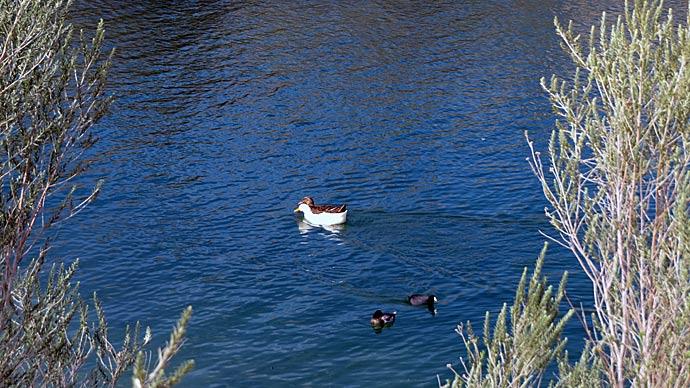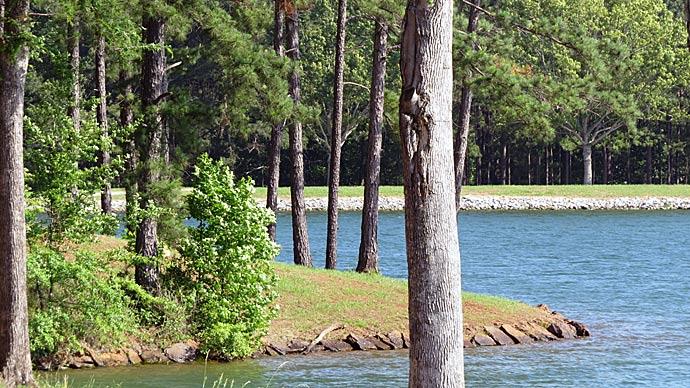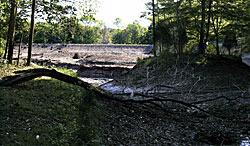
Tony Stewart drives fast. Really, really fast. Trust me, I've ridden with him. No, not in a race car, but in his Hummer, on "Roller Coaster Road," he calls it. It's a straight stretch of rural road west of his home town of Columbus. Indiana. His speedometer said "80" as my stomach stayed behind, dropped at the base of the last hill, poised to give it up again, at the bottom of the next mound. Then, as the speedometer pushed a wee bit faster, the lady strapped in the backseat questioned his driving skill. With a wry grin in the rear view mirror, he slowed it down to her more acceptable rural speed.
Stewart lives a fast paced life, literally. But, his roots are in his home town of Columbus. He lives in the house where he grew up. He and his family are close, and Stewart understands his fame with a humble heart. He is truly one of "us" even as his adoring public sees him as a fierce, fiery competitor on the track.
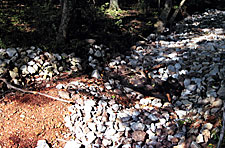
Several years ago, he purchased a beautiful tract of land, several hundred acres, just west of Columbus. With dramatic rolling hills covered with thick stands of hardwood trees, Stewart has found his own slice of heaven.
Nestled in the middle of the property is a cozy eight to ten acre lake, with a gorgeous home site just off the end of his 800 foot dam.
Long time Pond Boss readers remember the story of two years ago, when I first met Tony Stewart. BassPro Shop founder Johnny Morris found me that September day. flying home (or so I thought) from Syracuse. New York, to Dallas, connecting in Chicago. I never made that connecting flight. Johnny picked me up in Chicago in the BassPro plane, and we soon found our way on the ground, driving the rest of the way to Tony's ranch. For four hours we walked and talked about his lake, an empty hole in the ground at that time, teeming with heavy equipment, not fish.
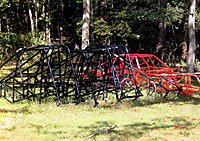
Johnny and Tony are good friends, and help each other on numerous occasions. This time, it was Johnny's turn to help. Tony was in the midst of renovating his lake. Bulldozers, trackhoes and dump trucks were burning up the bottom of the lake, hauling silt as fast as they could, and Tony needed some guidance how to build habitat, structure and cover to create the best bass lake he can have. For months, excessive amounts of silt were removed from the lake, taken behind the dam, spread out and mixed with topsoil, to later become wildlife feed plots. The lake was deepened, structure was added and the rains came. But, the rains came before the project was complete. So, Tony decided to drain the lake and finish. That took much of 2005.
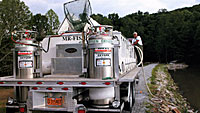
Roughly 20% of the lake bottom is now home to ridges, humps, rock piles, gravel beds and many different bells and whistles, perfect home for bass and the fish on which they feed. Shoot, there were several bent up sprint car frames lying in the yard, behind the house, near a shed. We decided those lightweight metal frames, made of some of the toughest metal on the planet, would be great fish structure. They now adorn an artificial creek channel just off the shoreline.
Stewart gave plenty of thought about the bottom of his lake. It also helps to have input from someone like Johnny Morris. He loves that sort of thing, too.
Over the last winter, different methods of stocking were considered and bandied about between Stewart, Morris and yours truly. Johnny leaned a bit more heavily to stocking the lake as though it had been there for four or five years. His belief is that Tony would enjoy catching big bass, fast. It only made sense. Tony does everything fast.
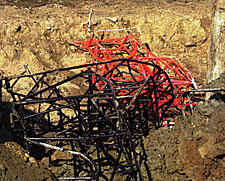
The biologist in me came out as well. If we were to stock adult bass, it made sense to find some feed-trained bass, and make sure they have enough forage fish to last a long time. So, with lots of time spent on lots of thought, and a fair amount of communication, the following stocking plan was decided. Fish were to come from as many hatcheries as possible, to ensure a good mixture of genetics. The marquee fish would be feed-trained bass, 1,200 pounds of the beauties, ranging in size from 3/4 pound to three pounds. At the same time, we stocked 30,000 2-3" bluegill, mostly native strains, but also few coppernose, just to see how well they perform in the middle part of the nation. We also stocked 10,000 3-4" sexually mature native bluegills with 1,500 adult bluegill, averaging 5 inches each. Along with those fish we stocked 3,000 redear sunfish and then a healthy dose of fathead and golden shiner minnows.
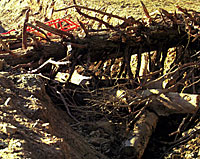
All told, the lake was stocked with enough fish to sustain those bass for most of a year. Then, four feeders were set up and filled with high protein fish food, and the management strategy is on. Tony and his friends are already reporting great catches of fish with deputy sheriff-sized bellies.
Just how does one put together such a sizeable stocking project? First, we had to know Tony's goals. Stewart spends lots of time in Charlotte, NC, driving, testing and preparing for the next race. Then, he jets off to the race, where he spends many intense hours pushing his machine to its limits while keeping 42 other guys with similar ambitions at bay.
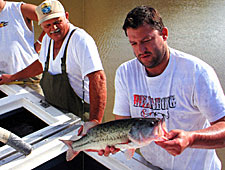
On Monday, he has a day off. Monday... that's usually it, during racing season. When he goes to the ranch to rest, relax and recreate, he ain't interested in a cane pole and a bobber. The man wants to catch fish.
Goal one, be able to catch plenty of fish, fast.
Goal two, be able to catch plenty of big fish, fast.
Goal three, re-read goal one and two.
As his biologist, my mission is to complete his goals, and be able to read the smile on his face every time we talk. So, feed trained bass make good sense. They are aggressive, grow quickly, and feed both in the food chain as well as the feed trough. After defining the strategy and making sure everyone agreed, the next task was to accumulate the fish and get them to Indiana. Enter Mr. Fish. Rodger Coffman of Lonoke. Arkansas. Coffmann has built a reputation for having the best equipment and knowing how to properly handle fish, all the way from the hatchery, to the road, to introducing them into the lake. Heck, Coffmann has been known to show up before daylight at a hatchery, to stand guard and make sure the hatchery technicians seined and handled the fish correctly from the pond. Rumor has it that he has even pulled off his boots, rolled up his pants and taken over a dip net inside a seine from time to time. I told Rodger, months ago, to be ready to stock this lake. Being a NASCAR fan himself, Coffmann couldn't wait. Every time we spoke, he asked if the lake was ready. When the time came he did what he does best. The logistics of trying to accumulate that many fish into a central location takes plenty of planning. Everything must come together, or there can be problems. Major problems. Remember, fish can die.

Rodger was a bit nervous. That's good. It means he takes outstanding care of every detail. Fish were ready, permits were in hand, everything was ready to go.
We had the schedule planned down to the minute. Rodger would congregate the fish in Lonoke, then load them late on Sunday night and head toward Columbus, Indiana, to arrive around 3 pm. I would fly from Dallas/Fort Worth, land in Indianapolis just before noon, where Tony's dad, Nelson, would pick me up for the one hour drive south to meet the fish truck. Tony would work through a press conference in Charlotte, then board his private jet and be in Columbus shortly thereafter. Good plan.
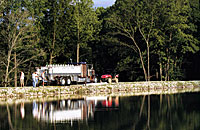
Didn't quite work out that way.
Lusk boarded his plane on time, at 5 a.m. to fly to Atlanta to connect to Indianapolis. Had 35 minutes to connect in Atlanta. No problem. Dallas flight was boarded, ready to take off, when the captain came over the loudspeaker. "Folks, there has been a discommunication." Discommunication? I had never heard of that word, but I knew it wasn't good. It seems the baggage handlers had overloaded the plane with freight and we were too heavy. You guessed it, missed the connecting flight in Atlanta. After a fiercely friendly spat with a gate agent who yields no authority. I was stuck. No worries. Called Tony's right hand man in Charlotte who quickly suggested catching a flight to Charlotte. Ride to Columbus with Tony. It worked. That gave me an extra couple of hours to visit with Tony and make sure we had a strong management strategy for the next year or two.

We made it to the lake site, and Mr. Fish went to work, with Tony and his dad side by side. Water was siphoned off the big fish truck, and then fresh lake water was pumped in its place. An hour and a half later, one side of the truck, ten compartments, was ready for departure. Big pipe in place, fish were flushed safely into the clean lake. Another hour and a half and the second side was ready.
The fish were handled properly. Tony, Nelson and their entourage were pleased, and the refreshed lake was freshly stocked.
There are several striking things about getting to work with these guys. Nelson Stewart, Tony Stewart, Johnny Morris, Mr. Fish.....everyone who is involved in this project is passionate for it to succeed. These guys not only love to fish, they love the environment in which the fish live, the shoreline around the lake, the trees on the mountainside. They all understand what they are doing is bigger than any of the single pieces of their natural puzzle. They are practicing conservationists, all the while doing what they do for a living, not losing sight of the prize.
Reprinted with permission from Pond Boss Magazine

